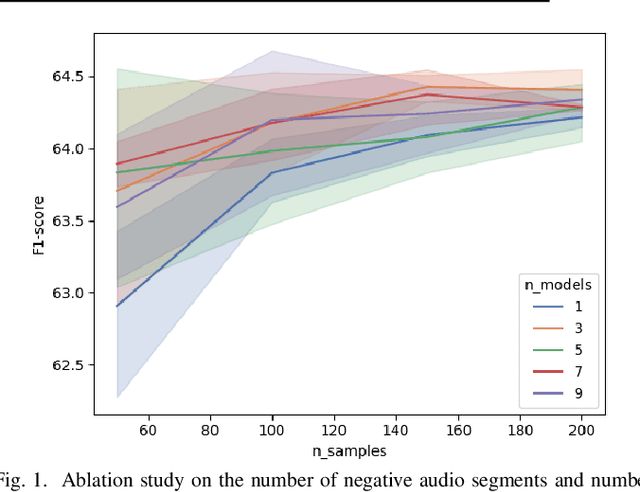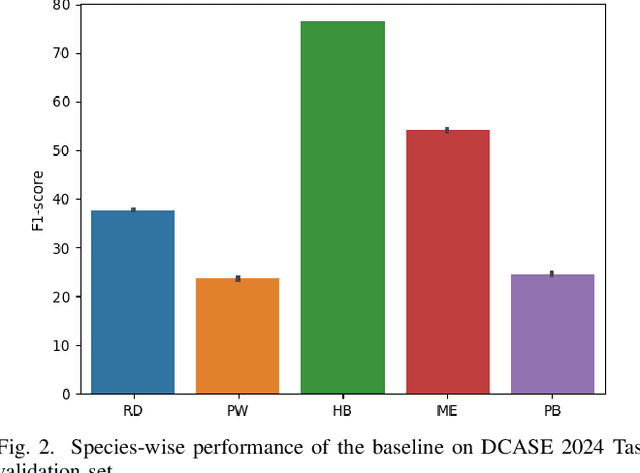Ines Nolasco
Acoustic identification of individual animals with hierarchical contrastive learning
Sep 13, 2024



Abstract:Acoustic identification of individual animals (AIID) is closely related to audio-based species classification but requires a finer level of detail to distinguish between individual animals within the same species. In this work, we frame AIID as a hierarchical multi-label classification task and propose the use of hierarchy-aware loss functions to learn robust representations of individual identities that maintain the hierarchical relationships among species and taxa. Our results demonstrate that hierarchical embeddings not only enhance identification accuracy at the individual level but also at higher taxonomic levels, effectively preserving the hierarchical structure in the learned representations. By comparing our approach with non-hierarchical models, we highlight the advantage of enforcing this structure in the embedding space. Additionally, we extend the evaluation to the classification of novel individual classes, demonstrating the potential of our method in open-set classification scenarios.
Mind the Domain Gap: a Systematic Analysis on Bioacoustic Sound Event Detection
Mar 27, 2024



Abstract:Detecting the presence of animal vocalisations in nature is essential to study animal populations and their behaviors. A recent development in the field is the introduction of the task known as few-shot bioacoustic sound event detection, which aims to train a versatile animal sound detector using only a small set of audio samples. Previous efforts in this area have utilized different architectures and data augmentation techniques to enhance model performance. However, these approaches have not fully bridged the domain gap between source and target distributions, limiting their applicability in real-world scenarios. In this work, we introduce an new dataset designed to augment the diversity and breadth of classes available for few-shot bioacoustic event detection, building on the foundations of our previous datasets. To establish a robust baseline system tailored for the DCASE 2024 Task 5 challenge, we delve into an array of acoustic features and adopt negative hard sampling as our primary domain adaptation strategy. This approach, chosen in alignment with the challenge's guidelines that necessitate the independent treatment of each audio file, sidesteps the use of transductive learning to ensure compliance while aiming to enhance the system's adaptability to domain shifts. Our experiments show that the proposed baseline system achieves a better performance compared with the vanilla prototypical network. The findings also confirm the effectiveness of each domain adaptation method by ablating different components within the networks. This highlights the potential to improve few-shot bioacoustic sound event detection by further reducing the impact of domain shift.
Few-shot bioacoustic event detection at the DCASE 2023 challenge
Jun 15, 2023



Abstract:Few-shot bioacoustic event detection consists in detecting sound events of specified types, in varying soundscapes, while having access to only a few examples of the class of interest. This task ran as part of the DCASE challenge for the third time this year with an evaluation set expanded to include new animal species, and a new rule: ensemble models were no longer allowed. The 2023 few shot task received submissions from 6 different teams with F-scores reaching as high as 63% on the evaluation set. Here we describe the task, focusing on describing the elements that differed from previous years. We also take a look back at past editions to describe how the task has evolved. Not only have the F-score results steadily improved (40% to 60% to 63%), but the type of systems proposed have also become more complex. Sound event detection systems are no longer simple variations of the baselines provided: multiple few-shot learning methodologies are still strong contenders for the task.
Rank-based loss for learning hierarchical representations
Oct 11, 2021
Abstract:Hierarchical taxonomies are common in many contexts, and they are a very natural structure humans use to organise information. In machine learning, the family of methods that use the 'extra' information is called hierarchical classification. However, applied to audio classification, this remains relatively unexplored. Here we focus on how to integrate the hierarchical information of a problem to learn embeddings representative of the hierarchical relationships. Previously, triplet loss has been proposed to address this problem, however it presents some issues like requiring the careful construction of the triplets, and being limited in the extent of hierarchical information it uses at each iteration. In this work we propose a rank based loss function that uses hierarchical information and translates this into a rank ordering of target distances between the examples. We show that rank based loss is suitable to learn hierarchical representations of the data. By testing on unseen fine level classes we show that this method is also capable of learning hierarchically correct representations of the new classes. Rank based loss has two promising aspects, it is generalisable to hierarchies with any number of levels, and is capable of dealing with data with incomplete hierarchical labels.
 Add to Chrome
Add to Chrome Add to Firefox
Add to Firefox Add to Edge
Add to Edge